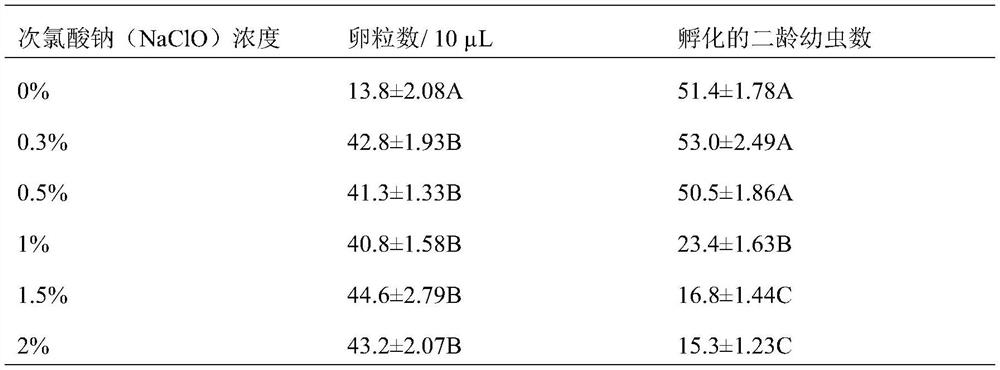Separation method of meloidogyne incognita eggs
A technology for the isolation of root-knot nematode incognita, applied in the field of agricultural plant protection, can solve the problems of research, inability to realize well, unfavorable biological characteristics of nematode eggs, etc., and achieve the effect of high egg activity
- Summary
- Abstract
- Description
- Claims
- Application Information
AI Technical Summary
Problems solved by technology
Method used
Image
Examples
Embodiment 1
[0027] Example 1: Effects of different lengths of tending on egg mass dissociation of Meloidogyne incognita
[0028] 1) Materials and methods: collect diseased roots of pumpkins infested by root-knot nematode incognita, and keep them moist at 28°C; after 12, 24, 48, and 72 hours, cut a small amount of root tissue and rinse thoroughly with tap water; Under a stereoscope, pick 10 (milky white) egg masses of M. incognita with tweezers from the diseased roots treated at different times, each of which contains 5 independent technical replicates (replicate); will pick The nematode egg masses were placed in a 1.5mL centrifuge tube containing 500μL sterile water; after centrifugation at 1600rpm for 2min, the supernatant was fully removed with a pipette; 1mL of sodium hypochlorite (NaClO) solution with an effective concentration of 0.3% was added to treat the nematodes Egg mass for 2 minutes, during which the samples were shaken repeatedly on a vortex shaker; centrifuge at 1600rpm for ...
Embodiment 2
[0030] Example 2 Effects of Different NaClO Concentrations on Meloidogyne incognita Egg Dissociation and Egg Hatching
[0031] 1) Materials and methods: collect diseased roots of pumpkins infested by root-knot nematode incognita, and place them at 28°C (moisturizing) for 48 hours; after that, rinse the diseased root tissue thoroughly with tap water; under a stereoscope, pick 10 seeds of the same size with tweezers. One (milky white) egg mass of Meloidogyne incognita; put the picked nematode egg mass into a 1.5mL centrifuge tube containing 500μL sterile water; centrifuge at 1600rpm for 2min, remove the supernatant with a pipette and divide into 5 parts ; In each centrifuge tube containing egg pieces, add 1 mL of sodium hypochlorite (NaClO) solution with an effective concentration of 0% (sterile water), 0.3%, 0.5%, 1.0%, 1.5% and 2%, respectively, wherein each treatment Including 5 independent technical repetitions (replicate); the sample was shaken repeatedly on a vortex shaker...
Embodiment 3
[0035] Embodiment 3: The influence of different treatment time of NaClO on hatching of eggs of Meloidogyne incognita
[0036] 1) Materials and methods: Plant diseased roots placed at 28°C (moisturizing) for 48 hours were thoroughly rinsed with tap water, and 10 (milky white) egg masses of M. incognita were picked out with tweezers; into 1.5mL centrifuge tubes containing bacterial water; after centrifugation at 1600rpm for 2min, remove the supernatant fully with a pipette; add 1mL of 0.3% sodium hypochlorite (NaClO) solution with an effective concentration of 0.3% to each centrifuge tube containing egg masses for treatment Samples 2, 5, 8 and 10min, during which the samples were repeatedly shaken on a vortex shaker, wherein each treatment contained 5 independent technical repetitions (replicate); the samples were centrifuged at 1600rpm for 2min, and the supernatant was discarded. Wash the samples 3 times with sterile water; add 500 μL sterile water, mix the samples and let them...
PUM
 Login to View More
Login to View More Abstract
Description
Claims
Application Information
 Login to View More
Login to View More - R&D
- Intellectual Property
- Life Sciences
- Materials
- Tech Scout
- Unparalleled Data Quality
- Higher Quality Content
- 60% Fewer Hallucinations
Browse by: Latest US Patents, China's latest patents, Technical Efficacy Thesaurus, Application Domain, Technology Topic, Popular Technical Reports.
© 2025 PatSnap. All rights reserved.Legal|Privacy policy|Modern Slavery Act Transparency Statement|Sitemap|About US| Contact US: help@patsnap.com



